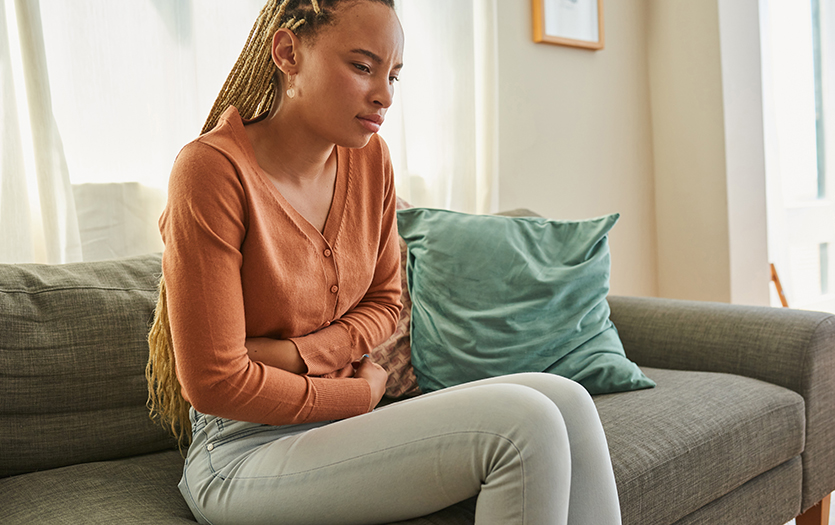
You are probably familiar with the term premenstrual syndrome (PMS), either from personal experience, or through the experiences of others. According to the Office on Women’s Health (OASH), over 90% of females report experiencing this set of physical and mood-related symptoms that occur one to two weeks before their menstrual period.
When does PMS begin?
PMS often presents in your mid-20s, though, according to OASH, it’s most common in a woman’s 30s. But symptoms can really start with your first period and continue until menopause. Since PMS is related to hormone changes that happen during your menstrual cycle, symptoms usually go away after menopause, when hormones are low and don’t rise and fall each month.
What are the symptoms of PMS?
Common physical symptoms of PMS include:
- Bloating, weight gain
- Fatigue, lack of energy
- Headaches
- Cramps, aching muscles and joints, low back pain
- Breast swelling and tenderness
- Food cravings, especially for sweet or salty foods
- Sleeping too much or too little
- Low sex drive
- Constipation or diarrhea
Other symptoms affect mood and behavior, including:
- A sad or depressed mood
- Anger, irritability, aggression
- Anxiety
- Mood swings
- Decreased alertness, trouble concentrating
- Withdrawal from family and friends
Unfortunately, symptoms of PMS can interfere with your daily life, but should go away in the first few days of your period. They may vary greatly from cycle to cycle and be worse during times of more stress.
How is PMS diagnosed?
There isn’t a single test that can diagnose PMS. Your doctor will ask questions about your symptoms and do a physical exam. It’s important to make sure that your symptoms aren’t caused by something else, so it may take more than one visit to fully diagnose your condition. Your doctor may want you to keep a written record of your symptoms for two to three months. This is called a menstrual diary, and it can help you track trends, including when your symptoms start, how bad they are and how long they last. Your provider can use these patterns and details to arrive at a diagnosis.
Sometimes, thyroid issues cause symptoms similar to those of PMS, so your doctor might order a thyroid stimulating hormone (TSH) blood test to make sure that your thyroid gland is working properly.
How is PMS treated?
There’s isn’t one treatment for PMS that works for everyone. Lifestyle changes, such as healthy eating, regular exercise and cutting back on caffeine and alcohol, can help. If these adjustments don’t provide relief after a few menstrual cycles, your doctor can prescribe medicine for bloating or for more severe PMS symptoms.
How can I manage PMS?
Self-care for PMS means practicing healthy habits, managing pain and reducing stress. Introduce the tactics below one or two at a time to see if they are beneficial.
Keep a menstrual diary.
Write down your symptoms, how severe they are, when you have your period and when you ovulate. This can help you find patterns in your cycle and plan ahead to better cope with symptoms.
Practice healthy habits.
Get at least 2½ hours of moderate exercise a week. Movement may help relieve pain and mood-related PMS symptoms.
Eat a variety of healthy foods.
This can include vegetables, fruits, dairy products, whole grains and protein. Stay away from processed or high-sugar options, and limit food and drinks that make your symptoms worse, like caffeine, alcohol or salt.
Quit smoking.
Manage pain.
Ask your doctor if you can take a nonsteroidal anti-inflammatory drug (NSAID) such as naproxen or ibuprofen to relieve pain and reduce menstrual bleeding. You can take an NSAID one or two days before you expect pain to start. These medications work best when taken before and at regular intervals throughout the days you have pain.
Wear a more supportive bra, such as a sports bra, when your breasts are tender.
Reduce stress.
Try some relaxation techniques, such as breathing exercises, yoga or massage therapy.
Get enough sleep.
PMS can lead to restless nights, and has been linked to high instances of insomnia. When you’re experiencing pain or irritability, carve out a little extra time to get comfortable and practice proper sleep hygiene.
If you are finding the symptoms of PMS are interfering with the quality of your daily life, it’s important to bring up your concerns with your primary care provider or OB/GYN physician. They can help you form a plan to get relief and minimize the effects of your cycle.
Copyrighted material adapted with permission from Healthwise, Incorporated. This information does not replace the advice of a doctor.



